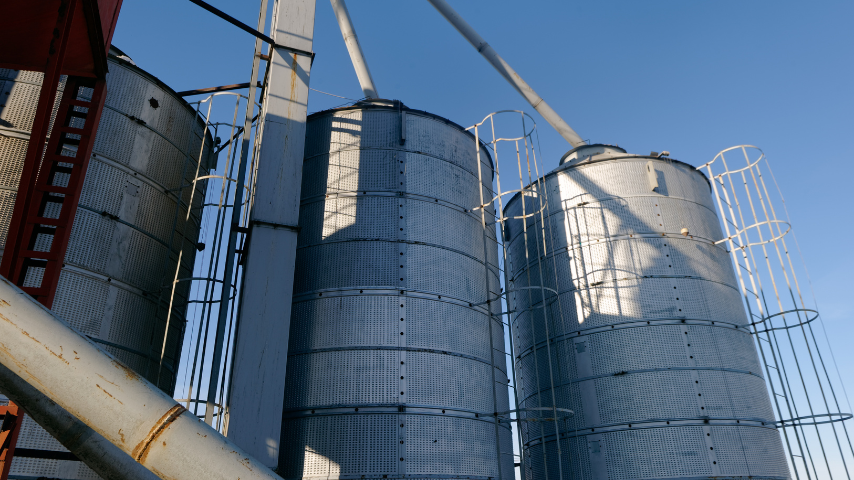Grain Systems and Grain Marketing

Grain must be stored carefully to keep it fresh and nutritious until being sold, which requires farmers to employ storage systems that regulate temperature and moisture content.
Work only with grain if you are well trained, competent and comply with governmental safety standards. Avoid situations that create engulfment hazards like flowing or bridged grain, as these could put yourself and others in harm's way.
Grain Storage
Grain storage is essential whether you're farming, stockpiling food for emergencies, or both. Grain storage protects food supplies by safeguarding against damage, degradation and spoilage; containers like baskets, jars and sacks as well as bins and silos at farms or grain elevators can all serve to store grains properly. As technology progresses so does farmers' tools used for storage of their crops.
Traditional grain storage structures on farms such as hoppers and bins were designed to protect grain against insects, rodents and moisture; however, due to limited capacity they cannot adequately prevent the accumulation of harmful microorganisms that cause bridging, crusting or spoilage of product.
Silos are among the most widely utilized on-farm storage structures. Constructed as tall cylindrical towers with airtight chambers and cylindrical bases, silos offer an effective means for keeping quality intact over extended periods of time. While initial investment can be costly, silos provide long-term preservation.
Silos can be constructed out of steel, concrete, or plastic and come in various sizes and capacities to suit the specific needs of each operation. As well as hermetic storage systems equipped with hermetic seals and hermetic fans for optimal hermeticity, some facilities also come equipped with flow retarders, aeration fans, dust suppression technology and dust aerators to enhance overall facility efficiency. Prior to storing grain in any structure it should be carefully inspected in order to maintain appropriate conditions - this also includes checking with local utilities for underground and overhead lines before proceeding with construction of grain storage structures.
Grain Processing
Grain processing refers to the transformation of grains into products useful in food production. This process typically includes cleaning, adjusting moisture content, mechanically reducing particle size reduction, fractionation (separating bran, germ and endosperm), dehusking, grinding hulling milling tempering parboiling soaking and drying processes.
Grain processors utilize various machines and techniques to clean, handle, ventilate and mill grain before sorting and classifying it for different uses. Furthermore, technology is employed to monitor crop health and detect disease or insect damage as well as near-infrared spectroscopy to identify contaminants or factors which could compromise its quality.
One of the advantages of this technology is its ability to reduce mycotoxin contamination and enhance bulk management, as well as decrease grain particle size - thus increasing surface area available for microbial colonization, increasing starch digestion rates and helping agribusiness fail-over rates during supply chain disruptions such as during Covid-19 pandemic outbreak.
Grain processing offers numerous advantages for consumers and livestock alike, including improving palatability and increasing nutritional value of foods to boost animal health and productivity. Furthermore, grain processing facilitates even cooking of grains as well as decreasing stomach issues like IBS.
Grain Transportation
Grain transportation involves shipping grain both domestically and internationally using various modes, including trucking, rail and barge services. Trucking remains the predominant mode in the US as trucks can transport larger volumes than trains thus enabling frequent and faster shipments and deliveries.
Railways offer the ideal solution for transporting grain over longer hauls, thanks to specialized containers and bodies designed to protect grains from moisture. Humidity can cause mold growth that ruins product and results in lost revenue; large railway operators have taken note of this trend and invested in new equipment like covered-top rail cars to safeguard their product and revenue stream.
The linear programming method produces optimization results which are then assessed from two perspectives: economic cost and resource benefit. On the supply side, Russia spends most on grain trade followed by Ukraine and Romania. Furthermore, water resource benefits of approximately 28x109 cubic meters have also been realized from this optimization result.
However, an input-output model fails to accurately assess international grain trade from a virtual water perspective and has limited spatial resolution. Furthermore, it does not take into account how scarcity and endowment differences of water resources across countries are key elements affecting international grain trade.
Grain Marketing
Grain marketing is the practice of selling grain for maximum profit using price tools that minimize price risk and enhance market returns. Effective grain marketing begins with creating a plan tailored specifically to each farm's goals; gathering impartial market information for analysis; and devising tailored strategies suited for their unique business requirements.
An effective grain marketing strategy centers around selling small quantities throughout the year rather than one massive sale at harvest time. Farmers should also explore hedging options as protection from drastic price drops.
As producers strive to maximize profit when selling grain, producers often prefer selling smaller units such as 1000 or 5,000 bushels at once. By selling grain in this fashion, producers can take advantage of any unexpected price rallies and "ladder" offers by purchasing and selling futures contracts representing portions of their physical grain stock at different prices.
To be successful at grain marketing, it's essential to access real-time exchange data and follow weather patterns closely. Furthermore, having a solid grasp on how grain contract terms operate under all market conditions helps farmers make sound decisions when hedging or speculating on commodities.
